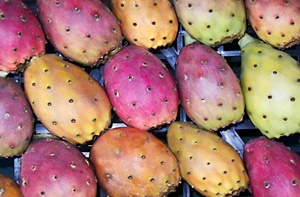Etude des constituants volatils et des polyphénols de la figue de barbarie «Opuntia ficus-indica (L.) Mill » du Maroc
Résumé
Le but de cette étude était l’extraction de composés organiques volatils (COVs) et les composés phénoliques totaux des variétés de figue barbarie «Opuntia ficus indica (L.) Mill» les plus répandues au Maroc à savoir Dellahia, Aissa et Shoul. Les COVs ont été extraits par microextraction sur phase solide (SPME) couplée à la chromatographie en phase gazeuse et à la spectrométrie de masse (GC-MS). Les composés phénoliques dans les extraits ont été étudiés par chromatographie en phase liquide couplée à la spectrométrie de masse (LC-MS). L’étude a permis l’identification de quarante-six composés pour les COVs. Les composés les plus abondants dans les trois variétés étudiées (Dellahia, Aissa et Shoul) sont le n-hexanol et le 2-hexanal avec respectivement un pourcentage de 10,6 %; 10,9 % et 44,0% pour le premier composé et 10,3 %; 59 %; 18,7 % pour le deuxième. L’analyse des composés phénoliques a permis l’identification et la quantification de 15 fractions de flavonoïdes et acides phénoliques. L’acide caféique est l’acide phénolique le plus abondant avec 16,0 et 10,8 mg/100 g de matériel végétal respectivement pour Dellahia et Aissa. Pour les flavonoïdes; isorhamnetin était le principal composé, il représentait respectivement 40,5 % et 43,2 % pour Dellahiaet Aïssa. Nous pouvons conclure que les fruits de figues de barbarie constituent une bonne source naturelle d’antioxydants naturels et par conséquent leurs bienfaits sur la santé sont inestimables.
Mots-clés: Opuntia Ficus Indica, SPME, LC- MS, GC-MS, composés organiques volatils, composés phénoliques
Téléchargements

Publié-e
Comment citer
Numéro
Rubrique
Licence

Revue Marocaine des Sciences Agronomiques et Vétérinaires est mis à disposition selon les termes de la licence Creative Commons Attribution - Pas d’Utilisation Commerciale - Partage dans les Mêmes Conditions 4.0 International.
Fondé(e) sur une œuvre à www.agrimaroc.org.
Les autorisations au-delà du champ de cette licence peuvent être obtenues à www.agrimaroc.org.

